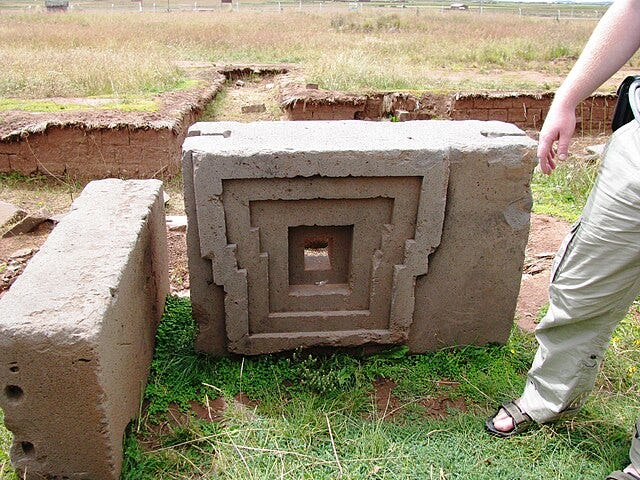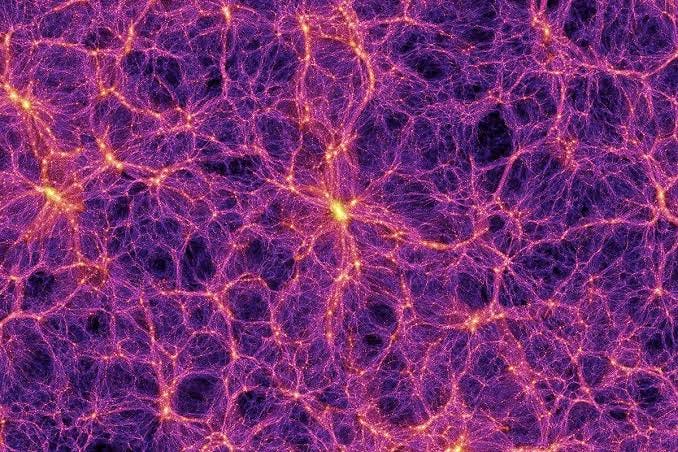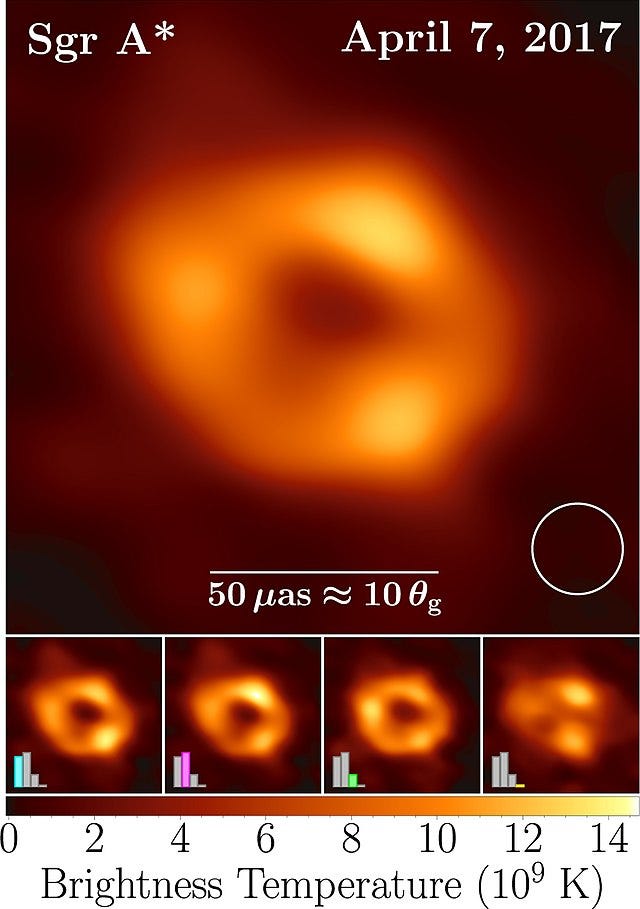Amazing Megaliths and The Beautiful Cosmos:
Wack Physics, Failed 'Consensus,' and Refuted Scientism
The Pyramid Valley, Bosnia. Dr. Semir Osmanagic looks on.
photo courtesy of Saša Nađfeji
Foreword:
This is a scientific post, but I hope that will not prevent non-scientists from reading it, because the subjects herein are intended to interest people who didn’t previously think they were interested in science. Specifically, this piece discusses the possible construction techniques used to build megalithic structures (structures build with extremely heavy blocks), and mind-blowing cosmological phenomena (I’ll touch on a few related subjects). If you doubt you’ll be interested, I encourage you to at least scan through the captioned photos in this article. This piece is written with as little jargon as possible, with the intent to enable the layperson to understand the content.
I’ve been meaning to write an article on the following topics, but have been swamped with writing my book on the war in Ukraine and the socialist agenda of the West. I was reading Tolstoy’s War and Peace a few nights ago, and, fighting falling asleep around 1:00 am, I decided to call it quits for the night. Thinking I would take a brief look at Facebook, I saw the post linked below this paragraph, about what is referred to as the Pyramid of the Sun, in Bosnia—a gigantic, brush-covered, four-sided, pyramid-shaped structure. Having previously seen a documentary about this alleged pyramid, I took interest in the post and two things caught my eye: (1) “blocks made of some type of concrete were found at the Sun pyramid's base,” and (2) “an electromagnetic energy of 28 kHz [i.e. 28,000 waves per second] emanating from the tip of the pyramid.”
Facebook Pyramid of the Sun post: https://www.facebook.com/photo/?fbid=309717378519681&set=gm.1450137148879477&idorvanity=535129367046931
For several years I’ve been intrigued by the subject of ancient ‘concrete’ known as geopolymer. Also, more than ten years ago I saw History Channel Ancient Aliens documentaries alleging that various megalithic structures were used to ‘channel energy,’ and was skeptical. More recently, I’ve been watching a plethora of excellent YouTube videos covering alternative scientific perspectives, mostly on two channels: Sky Scholar, by Dr. Pierre Marie Robitaille, and Thunderbolts Project, which has numerous brilliant contributors, including the late Wal Thornhill, Michael Clarage, David Talbott, Stuart Talbott, and many others. I’ve also read papers by these scientists, and by the scientists who’ve inspired them. Of course, in addressing the topics in this piece, my fallible understanding is subject to errors, and I hope readers will provide critique and feedback regarding the following overview of multiple topics.
The new perspective I’ve gained by examining the work of the aforementioned scientists made a light bulb click on when saw this Pyramid of the Sun Facebook post. I started writing into the early morning hours that night, and the following brief overview of several connected topics emerged. I plan to write more on these subjects in the future, but this piece will serve as a primer for those interested in the profound implications. I hope you will explore the links provided in this text, and you will find the linked videos contain beautiful, impressive images and footage, and fantastic explanations.
Geopolymers are an ancient ‘concrete.’ The concrete, reported by the attached Facebook post to have been found at the base of the Pyramid of the Sun, could probably be considered to be a type of geopolymer.
Israeli geopolymer scientist Dr. Joseph Davidovitz has reproduced the process for making blocks resembling those used in the pyramids in Giza, Egypt. Using simple materials available to the Egyptians, he made blocks with varying textures, which varied depending on the temperature and humidity level on the each day block was made. The varying textures resembled those observed in the structures of the pyramids. Dr. Davidovitz proposes that the majority of the blocks of the pyramids were made using this simple technique, of filling molds with material, packing it using a special pole with a flat piece at the end, and allowing it to cure. The blocks he made showed no evidence of the molds (no lines). Researchers published chemical analyses of the blocks at Giza, in this paper (< click link to read). The analyses affirm Davidovitz’ geopolymer hypothesis. In the paper’s summary, the authors write:
“The pyramid samples contained microconstituents (μc’s) [in other words, ‘ingredients’] with appreciable amounts of silicon in combination with elements, such as calcium and magnesium, in ratios that do not exist in any of the potential limestone sources.”
Davidovitz’ geopolymer explanation eliminates the need for gargantuan earthen ramps, cutting millions of blocks with copper-based tools, and other dubious aspects of the generally accepted explanations for how the pyramids were built.
Difficult-to-explain, intricate angles on a block at Puma Punku.
photo courtesy of Brattarb
Convincing evidence strongly suggests the H-shaped blocks, and other blocks at the megalithic site at Puma Punku in Bolivia, are also geopolymer, and they don’t look like stone. They look like concrete, and the odd ‘cuts’ have been described as ‘impossible.’ Using simple tools such as chisels and even hard stones like flint for cutting, and files for fine-tuning/finishing, the so-called ‘impossible’ cuts are in-reality possible; however, they would be extremely time-consuming to create, and the cookie-cutter, giant-‘Lego’ blocks—especially the ‘H’ shaped ones—appear molded by the same mold. Due to their odd shape, it seems unreasonable to have hand cut multiple blocks to this same shape. But with enough determination it is possible. Researchers believe the shape of the blocks was used to create interlocking structures.
Chemical analysis shows the blocks at Puma Punku contain organic material (biologically derived material from lifeforms), which should not be present, if they were made of cut stone. Along with the commonly held view that the blocks were made on an assembly line (amongst both, those who think they were cut, and those who think they were molded), the organic matter content is convincing that geopolymer was used.
'H’-shaped blocks at Puma Punku. This is an odd, difficult shape to replicate without a mold.
photo courtesy of Janikorpi
Coral Castle, in Homestead, Florida, has also been surmised to have been built by nonsensical explanations such as ‘sound levitation’ and ‘ancient alien’ technology, because the owner Edward Leedskalnin built them using a secret technique, by himself. His motivation for such secrecy was surely to create a mythology surrounding the construction, thereby creating allure to attract tourists, which he was very successful in doing.
The large, ‘stone,’ rotating door of Coral Castle, which rotated with an effortless push, at one point had to be repaired, and the repair crew said the hole ‘bored’ through the stone would have required a laser-precise drilling technique—not so! Its perfection may have resulted simply by geopolymer being poured around the steel column. However, ancient drilling techniques can be used to create precise holes, using a ‘tap-and-twist’ technique, or by a sand-aided friction/rotational technique using a pipe. So, the “laser-precision” claim could be exaggerated.
Coral Castle, Homestead, FL.
photo courtesy of Ebyabe
The raw material for Leedskalnin’s hypothetical geopolymer is readily available throughout Florida’s beaches. Although the stones were quarried onsite, layers of limestone have varying density, as the upper layers compress consecutively lower layers. Limestone is made of coral, diatoms (diatoms are silica-based, hard-shelled microscopic algae), shells, and bones. The upper, loosely compacted layers are ideal for making geopolymers. Additionally, coquina sand (sand composed of eroded coral and shells of varying sizes) is abundant in Florida, and may have been used, and notably, lime is the binder Dr. Davidovitz used in reproducing Giza pyramid blocks. The aggregate, amorphous nature of the Coral Castle blocks seems to indicate the possibility of them being made of geopolymer. Dr. Davidovitz has shown evidence that limestone of this texture is very difficult to distinguish from re-aggregated, limestone-based geopolymer. Leedskalnin’s pitch was that he carved and moved 1,100 tons of ‘coral rock’ on his own. Could he possibly have used leverage to move and elevate cut stones on his own? Yes, it’s possible. There are amazingly simple techniques (< watch this incredible linked video) he could have used. It is also possible that he used both geopolymer blocks and cut-stone blocks in the structure.
Coral Castle. Blocks like this can be raised by a back-and-forth seesaw technique (see linked video), rocking them with weights to one side (plus prying leverage under the raised side, if needed), then wedging more boards under the raised side, right next to the fulcrum point, and repeating the process, stacking more and more boards beneath the blocks. To move blocks, they can be rolled or pivoted. Also, points along the blocks, in the left side of this photo, indicate they were split from bedrock by hammering tapered metal rods into drilled holes.
Photo courtesy of Ebyabe
Experts and documentary producers investigating these megalithic monuments, who claim they were built using hocus pocus ancient alien technology, or even those who assert the more sensible old story of wet wood on immense earthen ramps, etc, refuse such a simple explanation as geopolymers, because it is so simple and elegant that it takes the fire out of the drama. Handing up baskets of wet material and tamping it down into reusable molds is less exciting than hauling blocks up huge ramps with crews of rope-pulling men, or the idea of aliens instructing humans. It is also possible the Egyptians used a more straight-forward, rocking and wedging technique to lift the stones from level to level, with no ramp at all. And the best scientific explanations are always elegantly simple.
Another aspect that I’ve not heard discussed, is my idea that geopolymers used in ancient Egypt enabled a much more practical carving of the hieroglyphs and other shapes that adorn monuments. Like pottery clay, when geopolymers were setting-up, but not yet fully cured, they could have easily been carved with copper or bronze tools. That is not to say it is impossible to carve hieroglyphs into stone, just much more time consuming and tedious, and much more prone to mistakes that can’t be erased—except perhaps with a geopolymer version of ‘white out,’ which may have been used even on real stone to correct errors, but that’s just my guess.
Now, considering that geopolymers were most-likely used to build some ancient structures, does not imply that all megaliths are made of geopolymers. This is a straw man logical fallacy often used in an attempt to refute the existence of such ‘concrete’ technology. The ancients did have the ability to cut stone extremely accurately using simple techniques and tools, including using harder stones for striking softer stones, and copper or bronze tools that required frequent sharpening. They also occasionally made weapons and tools out of iron from meteorites. Drilling lines of holes, and then hammering in slightly tapered metal shafts to split stones from bedrock, is also a technique known to the ancients. Stones in the Grand Gallery of the Great Pyramid appear to be sawn granite. Sawing granite can be achieved with a ~1/16th” thick copper blade with no teeth, using pumice for friction. Also, analytical evidence of stones at Sacsayhuamán near Cuzco, Peru, suggests they are indeed cut stone.
Nonetheless, the outer pyramid blocks in Giza, in their texture, analytical qualities, and sheer number (over 2 million), exemplifies a highly likely use of geopolymers. Likewise, the texture and analytical composition of blocks at Puma Punku suggest use of geopolymers. We might ask, ‘Why would you make walls out of individual blocks of ‘concrete,’ instead of a solid wall?’ A solid wall would have to be poured all at once, because otherwise the hardened segments would not bind to newly poured segments. This would not be too problematic in and of itself, since crews could work continuously in shifts. However, without reinforcing rebar, such a wall (or other structure) would be weak and prone to cracking from even minimal seismic activity acting on its foundation (or even from high winds, depending on the structure). By pouring individual blocks, blocks could shift and resettle during seismic activity. The ancient world was far more sophisticated than many people are inclined to believe, and to altogether refuse to acknowledge the use of geopolymers in ancient times is almost as absurd as ignoring the fact of concrete’s modern applications, and its use in ancient Rome.
Regarding the next eye-catcher from the Facebook post, I submit that the detected 28 kHz electromagnetic energy is not simply “emanating from” the tip of the Pyramid of the Sun, but is actually an electromagnetic current being exchanged between the Earth and the Sun in the form of Birkeland currents, and being conducted by the structure (if the 28 kHz energy was indeed detected). The subject of Birkeland currents is throughly discussed on the Thunderbolts Project Youtube channel. A Birkeland current consists of concentric layers of counter rotating currents; each consecutive layer twists in the opposite direction of the previous layer. If you’re unfamiliar with what “concentric” means, picture the layers of an onion (a concentric bulb). Weather phenomena on Earth, including trade winds, tornados, lightning, hurricanes, sprites, and ‘elves,’ and also earthquakes, volcanoes, and the aurorae borealis and australis, are all associated strongly with Birkeland currents from the Sun. Another great example is the counterrotation at the north pole of Jupiter.
North pole of Jupiter. Watch carefully in the bottom right quarter (and elsewhere), to see moving dark spots revealing counterrotation.
photo courtesy of NASA/JPL/Southwest Research Institute
Plasma is the ‘fourth state’ of matter: liquids, solids, gases, and plasmas. Lightning is glow-mode plasma, in which almost all of the molecules are in an excited, ionized state that emits light. But unlike lightning, plasma doesn’t have to be fully ionized and glowing, to conduct electrical currents. Partially ionized plasma is called “dark-mode” plasma. Allow me to acquaint the reader with the extent of my disapproval of much mainstream cosmology.
Miniature plasma currents in glow mode, in a plasma globe.
photo courtesy of Colin Click here for video version
The Sun is not a ‘ball of gas’ with nuclear reactions powering it; it is a ball of condensed matter, most likely liquid metallic hydrogen, as shown by brilliant spectrometric analysis, and other stunning evidence, presented by Dr. Pierre Marie Robitaille (in addition to the linked video, you’ll find dozens of videos on his channel about the Sun). Furthermore, the mainstream claim that the Sun is made of gaseous plasma defies our understanding of gravity and states of matter.
Active Sun, with solar flare (lower right), of height many times the diameter of Earth
photo courtesy of NASA/Goddard/SDO
Contrary to the nonsensical claim of general relativity—that ‘space-time’ fabric gives rise to gravity—we do not know the source of gravity. By extension, we don’t know what gives matter its mass. Don’t worry if you don’t understand the math in the following statement: We know that Newton’s equation, F = G(m1m2)/R2, accurately describes the force of gravity between two bodies relative to their masses and the square of the distance between them (G being a constant number: 6.6743 × 10−11 m3 kg−1 s−2), and that Newton accurately determined the acceleration of an object falling on Earth near sea level (omitting air resistance) to be 9.8 meters per second, per second. In other words, each second, the acceleration of Earth’s gravity on a falling object causes it to fall 9.8 meters per second faster than it fell the previous second.
So, we know what gravity does, but we do not know what causes gravity. Nonetheless, what we DO know about the force of gravity tells us that the body of the Sun must be made of condensed material—i.e. it must be liquid or solid, both of which are incompressible. Gases cannot retain their gaseous state under the immense pressure of gravity generated by a body the size of the Sun. Scientists claim that the visible surface of the Sun is just an illusion. But multiple factors tell us otherwise. The best information about this is found on Dr. Robitaille’s Sky Scholar channel.
The Sun’s energy comes from the even more-massive Birkeland currents than those between Earth and the Sun; these next-order Birkeland currents make up the arm of the Milky Way that our solar system is situated on. The Milky Way in-turn is situated on an even more-massive Birkeland current that is part of the ‘cosmic web.’
The cosmic web, as imaged in the x-ray frequency by radio telescopes. The ‘web’s’ fabric is Birkeland currents, which are dark-mode plasma, i.e. partially ionized gas that efficiently conducts electrical currents.
Bright spots along the currents are galaxies. Mainstream science acknowledges the magnetic fields of planets and stars, but essentially refuse to acknowledge the role of electrical currents in outer space. This flies in the face of logic, because we know that electrical currents and magnetic fields always coexist—this is principle behind electrical generators and motors.
photo courtesy of Volker Springel / Max Planck Institute For Astrophysics
Magnetism in an electric bass guitar: an electrical generator!
Like all electrical generators, electric guitars generate electrical current, as magnets move relative to one another. In other generators, a set of magnets rotates around a stationary magnet.
In electric guitars the back-and-forth vibration of the strings generates current: The strings are made of magnetized metals, and the pickup (black rectangle) is a magnet, which is wrapped in copper coils that are wired to the amplifier. As the strings vibrate at the frequencies of the notes being played, their magnetic fields interact with the magnetic field of the pickup, and the current generated by each note has the same frequency as the note. The current flows to the amplifier and is projected from the speaker.
photo courtesy of Simon Doggett
Aside from explaining the Sun is not powered by internal nuclear reactions (exciting electrical experimental models such as the SAFIRE project do indicate nuclear fusion occurs on the outer surface), this model also explains how the white color of ‘white dwarfs’ does not require unfathomable temperatures to achieve. Color temperature, as labeled on light bulbs in Kelvin (K) does not equal actual temperature. Stated simply, color temperature is a scale used for describing the color of light sources, relative to the temperature at which an idealized, standard material emits that same color (the material being non-reflective, black carbon). As stars are powered by electrical currents from without, not by nuclear reactions within, the color of white dwarfs does not require mind-boggling internal temperatures, just as white-light is emitted from fluorescent light bulbs that burn so cooly as to be able to be handled while alit.
There are many other fascinating topics in regard to Birkeland currents, too numerous to cover in this article, but in the future I will write shorter, more-specific pieces about some of them, including the electrical nature of comets’ tails, and the Valles Marineris on Mars. Hypothetically, Valles Marineris was carved by interplanetary electrical discharge during an epoch of solar system instability, when planets got too close to one another, and exchanged charge, like your finger getting shocked by a doorknob (thereby ejecting into the space the meteorites that fall to Earth which have the same composition as rocks analyzed by rovers on Mars).
The Valles Marinarus on Mars, displaying a pattern characteristic of electrical discharge, as observed in laboratory experiments. The valley stretches 1/3 of the way around Mars, and is as large as the entire United States. By the way, Mars’ diameter is only about half that of Earth. The valley goes up and downhill, irrefutably proving it was not formed by water.
The valley may have been formed in a matter of hours, as Venus (or another planetary body) approached too closely to Mars, and exchanged electrical charge, like your finger getting a static shock from a doorknob.
‘Pseudoscience’ genius Immanuel Velikovsky first proposed that Venus entered our solar system as a giant comet. Venus orbits the Sun in the opposite direction of the other planets.
photo courtesy of Kevin Gill
As noted by Pierre Marie Robitaille, plasma is not always gaseous. It also exists in liquid and solid phases. An example of Birkeland currents in liquid is the fascinating experiment in which two beakers are filled with water to the brim, and placed beak-to-beak. A strong electrical current is conducted from one beaker to the next, and then the beakers are slowly spread apart. What happens is astounding: a Birkeland current forms a horizontal, floating column of water between the two beakers (video here).
Birkeland current in pure water, between two beakers. Watch the amazing video!
As illuminated by the late physicist Wal Thornhill (RIP 2023 ❤️), mathematician Stephen Crothers, and others, there is no legitimate evidence for the existence of black holes. And the logical inconsistencies surrounding the fabled object are glaring. Images of concentrated stars encircling the center of galaxies are said to be a so-called ‘event-horizon,’ and stars that pass within it, or that reside, or are formed too close to it, to not be drawn into the ‘black hole,’ are ignored. Thornhill proposed that a plasmoid, at a z-pinch of our galaxy’s Birkeland current (named for physicist Kristian Birkeland who explained the aurorae), explains what makes ALL GALAXIES rotate at the same speed regardless of their size—they’re all on the same frequency of the same cosmic web circuit. Unlike ‘black holes,’ plasmoids have been produced in laboratory experiments. A z-pinch is a point where pairs of currents twist and form a plasmoid.
Black holes and ‘dark matter’ are used to explain the rotation of galaxies in the failed almost universally-accepted modeling that scientismists follow like zombies seeking funding instead of ‘braaaiinsss.’ Perhaps the best way to lose funding, or not get it to begin with, is by saying you want to conduct research refuting Einstein. Using a gravitationally based model, these imaginary, undetectable objects/materials are needed to explain the missing mass required to [quite poorly] explain the rotation of galaxies, whereas the electromagnetic force suffices to explain the rotational energy, the synchronicity of rotation of various sizes of galaxies, and the positioning of galaxies along the currents of the cosmic web. It also provides instantaneous effects—not limited by the average speed of light (I say ‘average,’ because light moves through different mediums at different speeds). Electricity works like someone pulling on one end of a long rope, and the person on the other end (barring elasticity) feeling the pull instantaneously. This is why a light bulb turns on immediately when you flip the switch, even when powered by a long circuit.
Mathematician Stephen Crothers points out that the ‘math’ used as the only ‘evidence’ for ‘black holes,’ is not even mathematical. They are conveniently unobservable and undetectable because ‘no light can escape their infinite density/gravity.’ Nonsense! You can’t use infinities as substances/substantial entities in math. Note however, that it is common to outright lie about this, by saying we have observed black holes. For example, Phys.Org featured a piece by Brian Koberlein, in which the author claims:
“At the heart of our galaxy, there is a monster black hole. Known as Sagittarius A*, it has a mass of 4.2 million suns, and it's only about 27,000 light-years from Earth. Sag A* is the closest supermassive black hole, and one of only two that we've observed directly.”
Mr. Koberlein has the full support of mainstream science in making this false claim, which is a total distortion of the truth. We have NOT observed a black hole at Sagittarius A. Scientists have observed the clustering of illuminated material (stars, plasma, etc), surrounding what is claimed to be a black hole at Sagittarius A, in a ring shape. They claim this ring is an ‘event-horizon’ (i.e. the point beyond which ‘not even light can escape the black hole’—Dun Dun Dunnn…spooky, maaaaaaan). But one look at the blurry image of this supposed ‘black hole’ observation, and you’ll see it shows nothing more than a ring in space, the center of which reveals the blackness of space beyond the ring.
I kid you not, this is the photo (actual resolution) that’s said to be a black hole we’ve “observed directly.”
photo courtesy of iopscience
Black holes and dark matter are also symptoms of a disease in physics: the reliance on math. Math is a descriptive tool—a language, if you will—to describe or model already observed phenomena. It is not a way of discovering things. But this has become a primary activity in modern physics. Instead of making physical observations, and then describing them with mathematical models, physicists have gone off the deep end, into writing equations and then looking for phenomena that they ‘discovered’ with math, or as Einstein did—with ‘thought experiments.’ They even in cases have abandoned looking for anything at all, and built mathematical theory on top of mathematical theory, and called it physics. This has led to nonsensical propositions of black holes, dark matter, dark energy, worm holes, a Big Bang, multiple dimensions (albeit I believe in Heaven and Hell), parallel universes, multi-verses, string theories, time travel, and other unscientific concepts. It is not just fantastical fiction, it is a serious hinderance to scientific progress. Sure time travel makes great movies like Terminator 2, but it’s not scientific.
General relativity and special relativity are also proven to be pseudo-mathematical nonsense, parroted by ‘experts’ who claim we’re just not smart enough to understand their illusionary maths. In a way, they’re right, since they’re able to present them as being indisputable. The conclusions drawn from general relativity, including the existence of black holes, and the Big Bang, use infinities as magical, supposedly tangible quantities. Nuclear physicist Pierre Henriquet, of the Institut Polytechnique in Paris, absurdly writes:
“As counter-intuitive as it may seem, two different infinities can have the same size, but, conversely, not all infinities are equal.”
Oui. Bien sûr. Just like “All animals are equal, but some animals are more equal than others.” —G. Orwell
Infinity can’t logically be used in an equation to equate anything. However, there are legitimate uses of the abstract concept of infinitely small quantities effectively acting as a zero quantity denoting an exact location in time or space: The abstract concept of infinitesimal is used mathematically in the place of ‘zero’ for a point that cannot possibly have ‘zero’ area, volume, or duration (point in time), since it must necessarily exist.
Dark matter is another conveniently undetectable blank check to fill in the ‘missing mass’ in a failed paradigm. Scientific American says that it makes up 80% of the mass of the universe. It is even said to make-up up to 99.99% of the mass of some galaxies! This is absurd on its face—the idea it is legit to use an undetectable entity to make an equation work, is like a jocular magic trick, telling us to turn around while the magician makes a tiger disappear. The concept of dark matter is 99.99% nonsensical and 100% wrong. Unlike ‘dark matter’ that you can’t see, once you see this fallacious reasoning, you can’t unsee it. Mainstream scientists incorrectly rely on gravity, instead of electricity (the electrical force was proposed to be a primary organizational force in the universe by 1970 Nobel Prize-winning plasma physicist Hannes Alfvén, and many others) to describe observed phenomena. By using the wrong force to describe galactic motion, the math describes the observed phenomena so poorly, that up to 99.99% of the mass needed to make it work is missing.
Image of dark matter:
Image courtesy of NASA…just kidding.
Although excellent electrical models are developing rapidly in free-thinking circles, all scientific models must be continuously scrutinized, as a basic tenet of the real scientific process. As an example of the importance of scrutiny, the ancient Greek geocentric (Earth-centered) model of the solar-system was highly predictive. The Antikythera mechanism relied on a geocentric model, and when the operator turned a crank on the side it to a future date, it was able to accurately predict the moon phases and locations of planets and constellations decades into the future, using a complex gearing system connected to display dials. We now see the geocentric model as primitive, and we use a slightly modernized version of Copernicus’ heliocentric (Sun-centered) model that Galileo was deemed a heretic for advocating; but I repeat: the geocentric model was predictive, and highly valuable.
The Antikythera Mechanism, at the National Archaeological Museum, in Athens, Greece.
It was found in ship wreckage at the bottom of the sea, at a depth of 148 ft, off the island of Antikythera, which lies between Crete and the Peloponnese, at the boundary between the Aegean, Mediterranean, and Ionian Seas.
photo courtesy of Tilemahos Efthimiadis
The Antikythera Mechanism had three ‘clock’ faces, which displayed the locations of planets, constellations, the moon phase, the next Olympic Games (this location was alternated on a rotational basis throughout the empire), and more. By turning a handle on the side to a future date, the faces simultaneously displayed all of this information.
photo courtesy of Giovanni Dall'Orto.
Gearing in a reproduction of the Antikythera Mechanism, created by x-ray, ultrasound, and physical examination of the remnants of the device. The Antikythera mechanism was very precisely predictive, even though it relied on the geocentric model (Earth at the center of the Universe). This shows that just because a scientific model is useful, that doesn’t make it correct.
photo courtesy of Kgbo
Real science continually tests new hypotheses, and acknowledges failures and new observations. Interestingly, Galileo’s being deemed a heretic is a good example of the crucial need for free speech. But unfortunately, the monopoly on thought imposed by ‘scientific’ journals is diametrically opposed to free speech. While peer-review is valuable, it can also be a group think factory, blocking free speech. When scientists wish to publish controversial work, they’re often denied publication in major journals; when they then are accepted into lesser known journals, the mainstream asserts that those journals aren’t scientific! They are accused of being pseudoscience—the science version of the ‘conspiracy theorist assertion.’
Three examples of this ‘pseudoscience’ problem are fields of (1) alchemy, (2) phrenology, and (3) Lamarckian genetics. These are all examples of so-called ‘pseudoscience’ that have been vindicated. In brief:
(1) Alchemy led to modern chemistry, and transmutation of elements has been proven to occur. It happens in electrical discharge experiments (SAFIRE project), inside of plants and animals (< also in this link is the superior, structured atom model), and is highly likely in natural lightning and discharges between planetary bodies, as shown in this Earth-shaking presentation by Peter Mungo Jupp (here is another, 7-min presentation by Jupp that is also excellent). Albeit a detailed explanation is beyond the scope of this paper you’re now reading, I should also mention that the amazing flaws in carbon dating render it falsified, though it is widely treated as scientific ‘fact.’
(2) Phrenology was the study of the shape of the skull, alleging that certain shapes, bumps, sizes, and so on and so on, could indicate personality and intelligence traits. Although as in other fields of science, flawed phrenological hypotheses were made, phrenology led to the modern conception of distinctive regions and sectors of the brain having specific responsibilities. Phrenology was not in-fact a ‘pseudoscience.’ Calling it such is like saying that Greek geocentric ideas were not cosmological, or were ‘pseudoscience,’ because they didn’t place the Sun at the center of the solar system. Ironically, phrenology also paved the way for psychologists, therapists, and psychiatrists to assert that they are engaged in real science, so they can sit back and offer their two cents for the price of many thousands of cents, and prescribe drugs in the name of mental health.
(3) Jean-Baptiste de Lamarck (1744-1829) is the scientist who was ridiculed when you were in high school (if you're my age or older), for his evolutionary theory that was rejected in favor of Darwin’s competing conception. Lamarck believed that traits acquired in people’s lifetimes could be passed on to their children. When I was in high school, Lamarck’s view was said to have been disproven by chopping off a mouses tail and showing that the mouse’s offspring did not inherit that trait. Yes, really. Of course this is absurd, and by the time I was at horticultural science student at University of Florida, a new field called epigenetics had emerged, which proved that the total set of genes we each have is not fully used, and depending on our environment, certain genes are ‘activated.’ These activated genes can then be preferentially passed on to our children. Like Lamarck, a Soviet plant scientist named Trofim Lysenko (1898-1976), believed plants could inherit traits based on the conditions encountered by their parent plants. He was regarded as a pseudoscientist, and largely still is, even though his views have been vindicated by epigenetics.
But ma chère! I’ve digressed, as usual.
Hubble telescope image of the beautiful Ant Nebula, showing looping plasma structures resembling a form of plasmoid. This structure warrants further investigation of electrical concepts.
image courtesy of NASA, ESA & the Hubble Heritage Team
The Black Widow Nebula displays a belt-like clustering of stars at its waist, which may be orbiting a plasmoid at a Birkeland current z-pinch.
The electromagnetic force is perfectly conveyed by dark-mode plasma that is barely visible except for with radio telescopes observing x-ray frequencies, and I hypothesize dark-mode Birkeland currents are the reason constellations were mapped. Some connecting Birkeland currents may have been visible before light pollution. The temperature of space is O Kelvin (a.k.a. ‘absolute zero’), which is why it conducts electricity through partially ionized (dark-mode) plasma so well. Superconductors are know to exist only at extremely low temperatures.
Yes, the temperature of space is O Kelvin, not ~3 Kelvin as found at the Bell radio telescope in Holmdel, NJ, at an elevation of just 147 feet, and only miles from the ocean. The ocean radiates (emits) and refracts energy. Absurdly, scientists proposed there would be a ‘cosmic microwave background’ (detectable as a residual temperature) from the ‘Big Bang,’ and then they set out to find it! That is backwards scientific procedure. You observe something, and then attempt to explain it, not the other way around.
You don’t make up a ridiculous ‘theory’ about an infinitesimal point being the origin of all matter. An infinitesimal point is simply an abstract concept used legitimately only for area/volume-less locations when graphing on a coordinate system, or for estimating exact points in time for calculus purposes. You don’t turn a non-material point into an ‘infinitely dense black hole,’ or a ‘singularity exploding to create everything,’ as proposed by Einstein worshippers and Big Bang kneelers. Stephen Crothers points out (du-dun, chhhh) that a ‘singularity’ cannot simultaneously have infinitesimal volume and ‘infinite’ density. It is double-think, à la 1984.
You see, an infinitesimal point is simply a necessary mental construct, since a dot on a graph must necessarily have area for you to draw it (or to even imagine it), albeit small. But when you draw a dot on a coordinate grid and say that the x, y, z coordinates, for example, are (0, 0, 0), you’re implying an exact location with no area, even though you can’t possibly depict that abstract concept. Similarly, time can be endlessly divided into smaller and smaller units, but in calculus, to determine, for example, the speed of a falling object accelerating at 9.8 meters/second per second, at an exact point in time, you assign the duration of that point in time an infinitesimally small value. Like the point-on-the-graph example, you are mathematically treating that point in time as having zero duration. The only reason you call it an infinitesimal duration, instead of actually writing ‘0,’ is that if it doesn’t have duration at all, then it doesn’t exist, and because, mathematically, zero times anything else is zero, which is undesirable for this cause. These are two legitimate uses of concepts of infinity, albeit abstract and physically insubstantial. However, there is no place in mathematics for infinitely large, perversely substantial quantities. That is unjustifiable nonsense. It is double-think to say that the center of a ‘black hole,’ or the origin of the ‘big-bang’ is/was a ‘singularity,’ with both infinitesimal volume, and infinite density. Density is mass per volume, or essentially weight per volume. In other words, density requires volume. The idea of a ‘singularity’ having both infinitesimal volume and infinite density, is really no different than the Ministry of Love forcing Winston to say that 2 + 2 = 5.
Refuting the flawed telescopic finding in Holmdel of the cosmic microwave background, the spectacular Herouni radio-optical telescope, a.k.a. the Orgov telescope, in Armenia, was built at an angle and elevation in the mountains that prevented it from detecting interfering signal from the ground or ocean, and Dr. Herouni found the temperature of space was O Kelvin, thus, there is no ‘cosmic microwave background.’ There was no ‘Big Bang’!
The magnificent Herouni Radio-Optical telescope. The thousands of reflective panels were handcrafted and polished. The electronics need updating, to restore the operation of the telescope.
photo courtesy of Դավիթ Մինասյան
The other ‘proof’ of the ‘Big Bang’ is the red shift of galaxies. Yes, there is a Doppler effect on light, as there is on sound, for example when a siren increases in pitch as an ambulance approaches (shorter, compressed sound waves), and decreases in pitch (longer, stretched sound waves) as it goes past. Red light is of longer wavelength than blue, and the length of light waves being emitted from an object are compressed as the object approaches an observer, and are stretched as the emitting object moves away. But this is not the only reason why objects in space are different colors. Cooler systems are redder, and vice versa.
It has been demonstrated that galaxies in the foreground sometimes have redder color than background galaxies directly behind them. Like ambulance siren sound waves, light from more-distant background galaxies should have longer wavelength and be more-red, in a supposedly expanding universe, since in such a model, all galaxies in space are moving away from one another. But this is not the case. Thus, the two ‘proofs of the Big Bang’ are disproven.
The age of the galaxy is unknown. Absurdly, we’ve been told the galaxy is “known” to be 13.8 BILLION years old. Even more absurdly, scientists recently changed their minds and doubled that number.
Concerning General Relativity: scientists use an imaginary four-dimensional Euclidean coordinate system to ‘prove’ general relativity with math. None of the proofs are legitimate. Inserting time into an equation is legitimate, but you can’t visualize an x,y,z,‘t,’ four-dimensional grid, because it is nonsense. Scientists have taken two immaterial but measurable concepts—space (distance), and time (duration)—and turned them into a material substance called ‘space-time,’ the fabric of which is supposedly warped to create gravity. You can’t make a material out of immaterial concepts. Not only is the grid itself un-visualizable, so is ‘space-time’ being warped in a way that allows gravity to work in all directions. The way this is depicted is like a ball indenting soft fabric, causing other objects to spiral down and around the indentation. Furthermore, warping a pseudo-fabric to create gravity, is using gravity to explain itself.
Depiction of so-called ‘space-time,’ a mentally fabricated imaginary material, materialized by combining two immaterial concepts (after eating magic mushrooms?) to explain gravity. Many people may be unaware that Einstein doubted some of his own theories. But the theories’ wild concoctions brought him fame and acclaim.
As you can see, this image is an attempt to depict a ‘4-dimensional’ concept, using a 2-dimensional grid sheet, indented to create 3-dimensional depth, to describe a concept that can’t possibly work 3-dimensionally. Got it?
image courtesy of NASA
In 1919, Sir Arthur Eddington supposedly observed, during the solar eclipse, ‘gravitational lensing,’ by ‘warping space-time,’ which Einstein described in a paper he published in 1915. Observational evidence refutes this bogus-math-based idea. Dr. Ed Dowdye (ex-NASA, ex-Department of State, ex-Department of the Navy) has analyzed this thoroughly, and eloquently explained that the observed light-bending is simply caused by diffraction, like when you see a handrail appear to bend as it enters a swimming pool. He also notes in this video:
“Einstein stated that if one of his three central proofs were determined to be wrong, his entire theory would collapse…in fact, all three of the observational proofs which Einstein had advanced, can be shown to be invalid.”
According to general relativity, warping of light should occur at some distance from stars, but it only occurs within the atmosphere of the star—i.e. it’s diffraction-caused, not ‘gravitational lensing.’
We are gas lit in being told that clocks on GPS satellites could not be set without accounting for relativity, because they change the speed at which they tick due to ‘changes in the fabric of space-time.’ This more hogwash. It’s true they tick at different rates at different altitudes due to varying gravity. But this is not proof of something happening to time itself. In other words, it is not relativity affecting time per se. It is simply a fact of the mechanical device itself, i.e. the clock. Clocks are affected—not time! This requisite time adjustment is ludicrously said by zealots to be proof of relativity. All it is is proof that gravity effects clocks. They’re mechanical, and therefore their mechanisms are subject to forces such as gravity.
Ron Hatch has extensively refuted the fictional notion that satellite calculations depend on relativity. In this video, in which he refutes the alleged role of relativity in GPS, he opens his presentation with these two gems:
-Reliable experiment trumps any theoretical claim.
-Rational explanation trumps any magical mechanism.
Hatch then quotes King Solomon: “It is the glory of God to conceal a thing; but the glory of kings to search out a matter.” -Proverbs, 25:2
Hatch created the mathematical algorithms for John Deere’s GPS systems that guide tractors to less than 1” precision, to avoid crushing crops when tractors are on autopilot driving down narrow rows. He would know if GPS depended on relativity. The clock issue is simply a mechanical phenomenon. It has nothing to do with time itself. If a clock speeds up or slows down, that does not mean time itself is responsible.
In summary, megaliths do not require ‘ancient alien’ technology, or mystical sound levitation, etc. Simple techniques can be used to cut or fabricate blocks, using basic tools and materials. Moving such blocks can be achieved by clever, straight-forward means, or they can be molded in place.
Cosmology and physics have relied upon a failed paradigm, and the crisis in science that has resulted becomes more and more apparent as technology enables better and better collection of observational data, and scientists attempt to repair the leaks by patching them with evermore ‘dark’ gobbledygook and the like. The dogmatic view of established science, known as scientism, goes against the principles of the real scientific process.
One overarching problem in science is hyper-specialization. Imagine science as a tree with branches: if you operate solely as a specialist out on the twigs at the tips of the shoots, you may not realize that the entire branch you’re on is rotten, until it breaks off of the tree.
Thanks for reading! God bless you.
Please subscribe to The Bender Observatory!

























